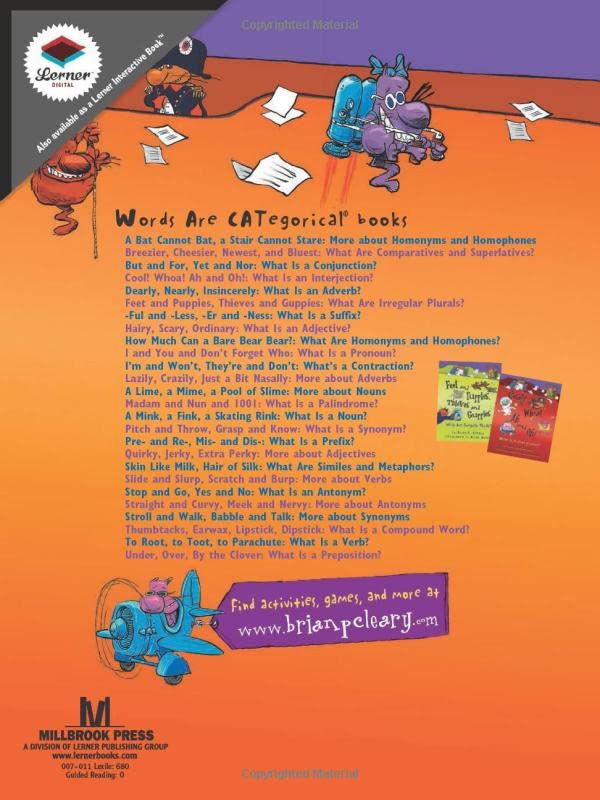


A Bat Cannot Bat, a Stair Cannot Stare: More about Homonyms and Homophones (Words Are CATegorical ®)
E**G
Great for understanding the awful quirks of the English language!
Words that sound alike, but different meaning and spelling! Yikes! What a chore learning English language rules and quirks! This is one of 27 little books that help learn grammar and writing skills. Beautifully illustrated and easy to understand. Great for all age groups, ESL instruction, and for students with special learning needs! Wish these books were available when I taught sixth grade years ago and even when I read and graded awfully written papers from graduate students with one or two degrees!
D**O
Great Book for Homeschooling
This was the newest release in this series of books by Brian P. Cleary, we have all of the others, and I had to have this book to go with all of the other books.
C**Y
Never ordered
Never orderred. What zre you doing
D**R
This CATegorical book on how to differentiate homonyms and homophones is a marvelously fun way to learn English grammar ...
If you’re a classroom teacher or a homeschooler, you are probably always looking for ways to make grammar easy and fun to learn. As soon as you take a look at the zany CATegorical cats and the way they present the concepts of both homonyms and homophones and other English grammar rules and lessons, your students will never be the same again. A few sessions with these cats and even your most reluctant student will be able to tell you all about both of these concepts and how to use them. Each homonym and homophone in this book can be easily spotted as they are highlighted in color. A very prim looking CATegorical cat teacher in the front of the book, points to an easel that defines them as follows:“Homonyms: two or more words that are pronounced the same and spelled the same but have different meanings.”“Homophones: two or more words that are pronounced the same but have different meanings.”The CATegorical cats romp through this book in their own magical way showing examples of both. For example, when one of those cats is shown fighting a fire he declares to a blue ox in a car, “The steer should steer clear of the fire.” Of course we are looking at a homonym. Yet another example can be found when some very hot, suffering cats are seen in some grandstands fanning themselves: “And fans could bring fans to cool off in the stands.” When Cleary scoots on over to examples of homophones, the fun continues. We see a crazy, hip, mop-topped blue hare (a CATegorical cat in disguise) pretending to play the guitar to a tune on the radio: “A hare can have hair.” The examples simply pop from the pages to help emphasize concepts that are sometimes difficult to grasp.This CATegorical book on how to differentiate homonyms and homophones is a marvelously fun way to learn English grammar. I’ve read several of the CATegorical books from those that teach easy ways to learn language concepts to the math books. I haven’t run up against any that I’ve felt are less than stellar and didn’t expect anything less from this one. The humorous, madcap illustrations give a lot of zing to the book, drawing in even the most reluctant students. This is a series that children gravitate toward and in conjunction with fun homeschool or classroom activities will make this book into an excellent language learning resource. In the back of the book are charts with an assortment of homonyms and homophones for students to explore. If you haven’t had the privilege of meeting any of the CATegorical cats, you just might want to take a look at the Words Are CATegorical series, a series you won’t regret buying!This book courtesy of the publisher.
N**Y
Think of this as a visual Schoolhouse Rocks for the next generation.
This book is incredible. Meant to be read aloud, sitting side by side, you and your young reader will learn the differences between homonyms (a group of words that share the same spelling and pronunciation but have different meanings) and homophones (two or more words that are pronounced the same as another word but differs in meaning). The illustrations along with the homonyms and homophones paired in color help you to understand the message that is being told. Be it as simple as a bat (an animal) cannot bat (a stick of wood) to the more complex base (the bottom of something) or bass (a low sound).This book makes an excellent teaching tool that pairs both the words and the visuals to help explain the differences. Told in rhyme, you will find yourself learning and laughing to the story that is being told.You also need to check out Brian P. Cleary’s Words Are CATegorical and Math is CATegorical books, where you can teach parts of English grammar and simple math structure. Think of this as a visual Schoolhouse Rocks for the next generation.
K**R
Not worth the money
too basic for the price. The whole book content took only under 2 minutes for my 9-year-old to go through.
Trustpilot
5 days ago
3 weeks ago